Whats That Red Dress Called Chinese Women Wear
 A woman in a cheongsam | |
| Type | Dress |
|---|---|
| Material | Silk, cotton |
| Place of origin | China |
| Cheongsam | |||||||||||||||||||||||||||
|---|---|---|---|---|---|---|---|---|---|---|---|---|---|---|---|---|---|---|---|---|---|---|---|---|---|---|---|
 "Cheongsam" in Traditional (top) and Simplified (bottom) Chinese characters | |||||||||||||||||||||||||||
| Traditional Chinese | 長衫 | ||||||||||||||||||||||||||
| Simplified Chinese | 长衫 | ||||||||||||||||||||||||||
| Literal meaning | long garment | ||||||||||||||||||||||||||
| |||||||||||||||||||||||||||
| Qipao | |||||||||||||||||||||||||||
| Chinese | 旗袍 | ||||||||||||||||||||||||||
| Literal meaning | banner gown | ||||||||||||||||||||||||||
| |||||||||||||||||||||||||||
Cheongsam (, ), also known as the qipao () and sometimes referred as the mandarin gown, is a Chinese dress worn by women which takes inspiration from the qizhuang , the ethnic clothing of the Manchu people.[1] The cheongsam is most often seen as a longer, figure-fitting, one piece garment with a standing collar, an asymmetric left-over-right ( youren ) opening and two side slits, and embellished with Chinese frog fasteners on the lapel and the collar. It was developed in the 1920s and evolved in shapes and design over years.[1] It was popular in China from the 1920s to 1940s, overlapping the Republican era, and was popularized by Chinese socialites and high society women in Shanghai.[2] Although the cheongsam is sometimes perceived as being a traditional Chinese clothing, the cheongsam continues to evolve with times as it responds to the contemporary modern life.[1]
Terminology [edit]
As English loanwords, both "cheongsam" and "qipao" describe the same type of body-hugging dress worn by Chinese women, and the words could be used interchangeably.[3]
The term cheongsam is a romanization of Cantonese word chèuhngsāam (長衫; 'long shirt/dress'), which comes from the Shanghainese term zansae . In Cantonese and Shanghainese, the term is used to describe a Chinese dress popularized in Shanghai. However, in Mandarin Chinese and other varieties of Chinese, chángshān (長衫) refers to an exclusively male garment, and the female version is known as the qípáo . In Hong Kong, where many Shanghainese tailors fled after the communist revolution of 1949, the word chèuhngsāam became gender-neutral, referring to both male and female garments.
The word qipao ( keipo ), which literally means "Bannerman robe" and originally referred to a loose-fitting, trapezoidal-cut garment worn by both Manchu men and women, became a more formal term for the female chèuhngsāam . Usage of the term "cheongsam" in Western countries mostly followed the original Cantonese meaning and applies to the dress worn by women only.
History [edit]
Background [edit]
The Manchu are an ethnic minority that founded the last of China's imperial dynasties, the Qing dynasty, which lasted from 1644 to 1911. When the dynasty was first established, dress regulations were implemented as a way of expressing their identity as a people and create social order. They used an administrative division called the Eight Banner system. Originally only the Manchu households were organized within this system, but over time naturalized Mongols and Han Chinese were incorporated. The Manchus, and anyone living under the Eight Banners system, wore different clothing from ordinary civilians; and thus, they became known as the Banner People (Chinese: 旗人; pinyin: qírén ; lit. 'banner person').
The type of qizhuang that both men and women typically wore consisted of long robes, which can be referred as the Manchu changpao and also categorized under the broad category of changpao (Chinese: 长袍; Chinese: 長袍; lit. 'long robe') or changshan (simplified Chinese: 长衫; traditional Chinese: 長衫; lit. 'long shirt').
Manchu men wore a changpao , which were designed for horseback riding, known as neitao , which was characterized by two pair of slits (one slit on each side, one slit on the back, and one slit on the front) which increased ease of movement when mounting and dismounting horses, a pianjin collar (a collar which curved like the alphabet《S》), and the sleeve cuffs known as matixiu (Chinese: 马蹄袖; pinyin: mǎtíxiù ; lit. 'horse hoof cuff').[4] : 27
On the other hand, some imperial Manchu women wore an changfu (常服), informal dress, which looked similar to the men's neitao known as the changfupao (常服袍).[4] There were also two styles of changpao for the imperial consorts, known as chenyi and changyi , became popular.[1] The chenyi and the changyi differed in terms of structure: the changyi had two high side slits which allowed for greater ease of movements while the chenyi had no side slits.[5] Both the chenyi and changyi differed from the changfupao lacking the matixiu cuffs.[5] Both the chenyi and changyi were also the changfu of the Manchu women; they also both became popular during the reign of Emperor Qianlong.[6] It is also theorized that the cheongsam was derived from the Manchu women's chenyi although the chenyi shows absence of slits.[1]
Introduction of Manchu-style clothing [edit]


Differences between the Chinese changshan (left) and Manchu neitao (right), Qing dynasty
Throughout China's multicultural history, clothing has been shaped through an intermingling of Han clothing styles, the Han Chinese being the dominant ethnicity, and the styles of various ethnic groups. Some examples of this include the standing collar of the qipao, which has been found in relics from the Ming dynasty, ruled by Han Chinese, and was subsequently adopted in Qing dynasty Manchu clothing items. The Manchu also adopted the right closure as from the Han Chinese as they initally closed their robes on the left side.

Han Chinese's women aoqun, Qing dynasty

Chenyi, a one-piece Manchu women's robe, Qing dynasty.
Left: A Qing-style aoqun, a form of Hanfu worn by Han women around the 19th to 20th centuries. Below their upper garment, this qun, skirt, is a mamianqun, a style which was inherited from the Ming dynasty and continued to develop in the Qing dynasty. Right: Lady Aisin-Gioro Hengxiang, the birth mother of Wanrong, wearing the traditional Manchu one-piece robe, a chenyi, that later inspired the cheongsam.
For a period of time under the dynastic laws during transition from Ming to Qing, all Han Chinese were forced to adopt the Manchu male queue hairstyle and adopt Manchu clothing under the Tifayifu (剃发易服; 剃髮易服; tìfàyìfú ) policy instead of being wearing the traditional Hanfu under the threat of death penalty. However, the order for ordinary non-Banner Han civilians to wear Manchu clothing was lifted, and only those Han who served as officials or scholars were required to wear them. Over time though, some Han civilian men voluntarily adopted the changshan. By the late Qing, not only officials and scholars, but a great many Han commoners wore Manchu-style male attire.[7] [8] However, until 1911, the Manchu changpao was required clothing for Chinese men of a certain class.
What is now known as the Chinese changshan was developed by the Han Chinese during the Qing dynasty.[4] : 129 The Qing dynasty Chinese changshan started to be worn by the Han Chinese after the Manchu conquest; the Chinese changshan was actually a modified version of the changshan worn in the Ming dynasty (1368–1644 AD), the preceeding dynasty before the Qing dynasty.[4] : 129 The Qing dynasty Chinese changshan was modelled after the Manchu's men's robe.[1] It thus adopted certain Manchu Manchu elements, such as by slimming their changshan, by adopting the pianjin collar of the Manchu, and by using buttons and loops at the neck and sides.[4] : 129 The Chinese changshan differed from the Manchu men's neitao as it only had two slits on the sides lacking the central front and back slits and lacked the presence of the matixiu cuffs; the sleeves were also longer than the ones found in the neitao.[4] : 129
For women, Manchu and Han systems of clothing coexisted.[9] Throughout the Qing dynasty, Han civilian women continued to wear traditional Han clothing from the Ming dynasty.[10] As a result, Ming dynasty style clothing was retained in some places in China until the Xinhai Revolution of 1911.[11]
Birth of the cheongsam [edit]

Chinese singer and actress Zhou Xuan wearing a cheongsam in the 1930s in Shanghai
The predecessor of the more well known qipao resembled the men's changpao. The changpao was a long gown commonly associated with the male literati class. The first 1920s iteration was androgynous and had a "wide, angular and puritanical cut"[12] This version was adopted primarily by activists and students who had studied abroad. This cross-dressing reflected, among other things, a desire for women to be seen as equals in the public sphere.
The version seen as the typical cheongsam in China today was popularized by the celebrities, socialites and politicians of the time in Shanghai from the 1920s to the 1940s. Former First Lady of China Madame Wellington Koo (Oei Hui-lan) was a prominent figure among them.[13] [14] Voted several times by Vogue into its lists of the world's best-dressed women, Madame Wellington Koo was much admired for her adaptations of the traditional Manchu fashion, which she wore with lace trousers and jade necklaces.[13] [14] Cheongsam dresses at the time had been decorously slit a few inches up the sides, but Madame Koo slashed hers to the knee, 'with lace pantelettes just visible to the ankle'.[14] Unlike other Asian socialites, Madame Koo also insisted on local Chinese silks, which she thought were of superior quality.[13] [14]
Further transformation [edit]

Two women wearing cheongsam and high-heel shoes in a 1930s Shanghai advertisement
Starting from the early 1930s, there was a further feminization of the qipao as it became increasingly shorter and tighter and thus arose an emergence of the female body. Consumer culture was also on the rise as Western and Chinese merchants co-operated to move towards capitalism.[15]
People eagerly sought a more modernized style of dress and transformed the old cheongsam to suit new tastes. Slender and tight-fitting with a high cut, it had great differences from the traditional cheongsam. High-class courtesans and celebrities in the city made these redesigned tight fitting cheongsam popular at that time.[16] In Shanghainese, it was first known as zansae for 'long dress', rendered in Mandarin as chángshān and in Cantonese as chèuhngsāam ; it is the last of these spoken renditions of 長衫 that was borrowed into English as "cheongsam".
According to the Clothing Regulations, the cheongsam needed to be worn with trousers and be calf-length, but with the introduction of Western fashion many people replaced trousers with stockings and added matching accessories. The side slits were re-purposed into an aesthetic design reaching the top of the thighs to reflect the new fashion trend. By the 1940s, trousers had completely fallen out of use, replaced by different type of hosiery. High-heeled shoes were another fashion trend introduced to Shanghai at the same time, and it became an essential part of cheongsam fashion set, which continued into modern days.[17] As trend of hosiery in turn declined in later decades, women started to wear cheongsam more commonly with bare legs. While this development settled the cheongsam as a one-piece dress, by contrast, the related Vietnamese áo dài retained trousers.
The modernized version of cheongsam is noted for accentuating the figures of women, and as such was popular as a dress for high society. As Western fashions evolved, so does the cheongsam design, with introduction of high-necked sleeveless dresses, bell-like sleeves, and the black lace frothing at the hem of a ball gown. By the 1940s, cheongsam came in a wide variety of fabrics with an equal variety of accessories.
The 1949 Communist Revolution curtailed the popularity of the cheongsam and other fashions in Shanghai, but the Shanghainese emigrants and refugees brought the fashion to Hong Kong and Taiwan where it has remained popular. Recently[ when? ] there has been a revival of the Shanghainese cheongsam in Shanghai and elsewhere in Mainland China; the Shanghainese style functions now mostly as a stylish party dress.
Popularity and women's liberation [edit]
The Republican period is the golden age of cheongsam. In exploring reasons behind its prevalence in Republic of China, many scholars relate it to the women's liberation movements. After the feudal Qing dynasty was overturned, Chinese feminists called for women's liberation from traditional roles and they led several movements against the Neo-Confucian gender segregation, including a termination of bound feet for women, cutting off long hair which was conventionally symbolized as women's "oriental" beauty, and encouraging women to wear men's one-piece clothing, Changshan or "changpao".
"Changpao" was traditionally taken as men's patent throughout the long history since Han dynasty (202 BC to 220) to Qing dynasty (1616–1911). During that time, Chinese Han female's clothing gradually developed into two pieces. Women were forbidden to wear robes as men did and instead had to wear tops and bottoms known as "Liang jie yi". After the Xinhai Revolution of 1911 (which overthrew the Qing dynasty), young Chinese people began to learn Western science and cultures in order to seek a way of saving the nation. Also, the opening of several ports and ceding territories of China to Western powers imported some Western ideas to mainland China. Among all these Western thoughts, the idea of gender equality quickly gained its followers, among whom young female students became its prime advocates.[18]
It was the May Thirteenth Movement of 1925, where anti-Westernization demonstrations persisted throughout the country, that served as an important push in the qipao's institutionalization. The Republicans declared the qipao a formal dress in the Clothing Regulations of 1929. The dress was meant to assert the importance of nationalism through rejecting Western forms of dress. That being said, there were still strict rules regulating how the dress needed to be worn including specifications about length, material, accessories, collar, buttons and sleeves, but curiously enough, none of these were followed.[19]
From the start, there was no unifying style for the dress like the Republicans intended; Chinese women had no respect for the Clothing Regulations of 1929 which tried to control individuality. There were endless variations in style, with adaptations to length, material, hemlines, collars, fabrics, patterns, colours and with the accessories it was paired with. It was worn by everyone from Shanghai sociolites to students, housewives, and prostitutes.[20] The style of the qipao was often in tune with fashion cycles and was influenced by Western trends seen through women styling it with matching scarves, fur coats and leather heels. Magazines such as LingLong also gave women access to dressmaking knowledge and normalized it for women to make their own dresses in their own style. The base form of the qipao is rather simple to sew, which makes it easily accessible and economical.
The style of cheongsam also varied due to Western influence. It changed from a wide and loose style to a more form fitting and revealing cut, which put more emphasis on women's body line. The length of cheongsam was also reduced from ankle reaching to above the knee.
The design of cheongsam got various inventions like ruffled collar, bell-like sleeves and black lace frothing. Starting from that, the priority of cheongsam moved from a political expression to aesthetic and ornamental emphasis.
Timeline of Chinese dress [edit]

Starting from the Qing dynasty, changpao, which was the early form of cheongsam, was the daily clothes of Manchus Bannerman. Apart from cheongsam, changpao was a long robe without sleeves and collars.[ citation needed ]
Until the 1920s, right after the overthrow of the Qing dynasty and founding of the Republic of China, cheongsam was originated in Shanghai. Cheongsam of the early 1920s had loose cutting, with long, wide sleeves. Affected by Western culture, cheongsam kept on changing, such as becoming more fitted and body-hugging, with side slits that reached up to the thigh.[21] [22] Moreover, numerous distinct designs were unveiled and cheongsam became a fashion trend.[23]
In 1929, cheongsam was chosen by the Republic of China to be one of the national dresses. In the 1930s, the fashion prevailed in Shanghai. At that time, cheongsam was made of silk and embroidered with pearls and other decorations. Also, they were close fitting, and drew the outline of the wearer's body.
In the 1940s, cheongsam was worn with stockings, and trousers had completely fallen out of use. High-heeled shoes became an essential part of the cheongsam fashion set.[17]
From the 1950s to the 1970s, due to the anti-tradition movements in China, especially the Chinese Cultural Revolution (1966–1976), the cheongsam was seen as a feudal dress of the ancient times. It was abandoned as daily clothing, and people who wore cheongsams were judged as being bourgeois, which was considered a political misbehaviour at that time. For example, in 1963, when Chinese President Liu Shaoqi visited four neighbouring countries in South Asia, first lady Wang Guangmei wore a cheongsam. She was later declared guilty in the Cultural Revolution for wearing a cheongsam.
Since the 1980s, with the trend of reevaluation of Chinese traditional culture, people in mainland China started to pay attention to the cheongsam again. The cheongsam is gaining popularity in films, beauty pageants, and fashion shows in both China and other countries all over the world. In 1984, the cheongsam was specified as the formal attire of female diplomatic agents by the People's Republic of China.
-

-

-
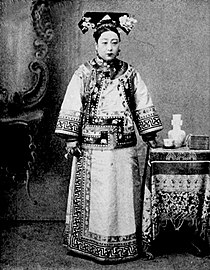
Guangxu Period
(1875–1908)
Lady Heseri -
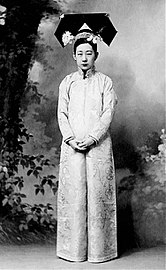
Guangxu Period
(1875–1908)
Lady Aixingioro Hengxiang -
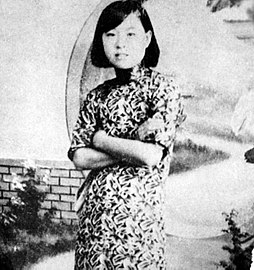
Modern use [edit]
Workplace [edit]

The uniform of Hainan Airlines cabin attendants based on cheongsam debuted in 2017, with a coat worn outside.
Some airlines in Mainland China and Taiwan, such as China Airlines[24] and Hainan Airlines,[25] have cheongsam uniforms for their women flight attendants and ground workers. These uniform cheongsams are in a plain colour, hemmed just above the knee, with a close-fitting wool suit jacket of the same colour as the cheongsam. It is also common for these uniforms to only borrow certain elements, such as the standing collar and frog clasps without adopting the whole design.

Cheongsam worn as a uniform by a restaurant hostess
In the 1950s, women in the workforce in Hong Kong started to wear more functional cheongsam made of wool, twill, and other materials. Most were tailor fitted and often came with a matching jacket. The dresses were a fusion of Chinese tradition with modern styles. Cheongsam were commonly replaced by more comfortable clothing such as sweaters, jeans, business suits and skirts. Due to its restrictive nature, it is now mainly worn as formal wear for important occasions. They are sometimes worn by politicians and film artists in Taiwan and Hong Kong. They are shown in some Chinese movies such as in the 1960s film The World of Suzie Wong, where actress Nancy Kwan made the cheongsam briefly fashionable in Western culture. They are also commonly seen in beauty contests, along with swim suits. Today, cheongsam are only commonly worn day to day as a uniform by people like restaurant hostesses and serving staff at luxury hotels.
School uniform [edit]
A few primary schools and some secondary schools in Hong Kong, especially older schools established by Christian missionaries, use a plain rimmed sky-blue cotton and/or dark blue velvet (for winter) cheongsam with the metal school badge right under the stand-up collar to be closed with a metal hook and eye as the official uniform for their female students. The schools which use this standard include True Light Girls' College, St. Paul's Co-educational College, Heep Yunn School, St. Stephen's Girls' College, Ying Wa Girls' School, etc. These cheongsam are usually straight, with no waist shaping, and the cheongsam hem must reach mid-thigh. The cheongsam fit closely to the neck, and the stiff collar is hooked closed, despite the tropical humid and hot weather. Although the skirts have short slits, they are too narrow to allow students to walk in long strides. The seams above the slits often split when walking and are repeatedly sewn. Many schools also require underskirts to be worn with the cheongsam. The underskirt is a white cotton full slip, hemmed slightly shorter than the cheongsam, and have slits at the sides like the cheongsam, although the slits are deeper. A white cotton undershirt is often worn underneath the cheongsam. The cheongsam's length, styling, color and sleeve length varies between schools. Many students feel it an ordeal, yet it is a visible manifestation of the strict discipline that is the hallmark of prestigious secondary schools in Hong Kong and many students and their parents like that. Some rebellious students express their dissatisfaction with this tradition by wearing their uniform with the stand-up collar intentionally left unhooked or hemmed above their knees. The Ying Wa and True Light Schools have sent questionnaires to their students about uniform reforms but have not altered their policies.[26] However, Madam Lau Kam Lung Secondary School of Miu Fat Buddhist Monastery ended their cheongsam uniform in 1990 after receiving suggestions from its student union.[27]
Festivities [edit]
Cheongsams are a popular choice of outfit for festive seasons like Chinese New Year. In countries with significant Chinese populations such as Malaysia, Singapore, Hong Kong and Taiwan, it is common for women to have new cheongsams tailored in preparation for the New Year. Cheongsams are also a popular choice of outfit for older women on formal occasions or family reunions. Upmarket fashion labels such as Shanghai Tang specialize in modern versions of the cheongsam as occasion wear.
Weddings [edit]
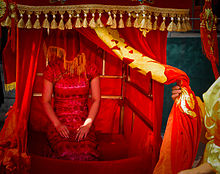
A bride wearing a red wedding cheongsam covering her face with a honggaitou (a red veil).
In Western weddings, Chinese brides or brides marrying into a Chinese family, will often wear cheongsam for a portion of the wedding day. It is common for many brides to have both a traditional white wedding dress and a cheongsam or a guaqun (another kind of wedding attire) to be worn during the tea ceremony. Cheongsam styles have also evolved to be more modern from mermaid silhouettes to semi-traditional styles that feature a cheongsam top with softer details like lace and a looser skirt.[28]
Lolita fashion [edit]
Some Lolita dresses are styled like a cheongsam. The dresses or jumper skirts are designed after traditional Chinese dresses. This style of Lolita fashion is called Qi Lolita.[29]
-
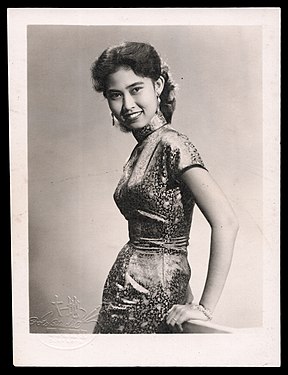
-

Typical modern cheongsam with high-slit cuts reaching top of the thigh
-
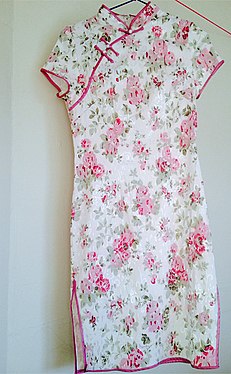
Typical modern cheongsam in short style above the knee
-

On the international stage [edit]
[edit]
In the 2008 Summer Olympics, the medal bearers wore cheongsam. Similar attire was worn by female members of the Swedish team and of the Spanish team in the opening ceremony, with the national colors.
For the 2012 Hong Kong Sevens tournament, sportswear brand Kukri Sports teamed up with Hong Kong lifestyle retail store G.O.D. to produce merchandising, which included traditional Chinese jackets and cheongsam-inspired ladies' polo shirts.[30] [31] [32]
Political stage [edit]

Cheongsam belonging to the wives of past Singaporean political leaders on display in an exhibition entitled In the Mood for Cheongsam: Modernity and Singapore Women at the National Museum of Singapore in 2012
In contemporary China, the meaning of cheongsam has been revisited again. It now embodies an identity of being ethnic Chinese, and thus is used for important diplomatic occasions.
Since 2013, Peng Liyuan, the first lady of China, has worn cheongsam several times while on foreign visits with Chinese leader Xi Jinping.
In November 2014, cheongsam was the official attire for the political leaders' wives in the 22nd APEC meeting in Beijing.
International fashion [edit]
With the growth of the Chinese economy, cheongsam has experienced a renewed popularity. Many Western designers have integrated elements of cheongsam in their fashion collections. French designer Pierre Cardin once said that cheongsam was his inspiration for many of his evening dress designs.[33] In many films and movies, cheongsam is used to make a fashion statement. The varied interpretations of this ethnic dress brings in debates of cultural appropriation and the designs being linked to Orientalism. In the 2011 movie One Day, Anne Hathaway wore a set of dark blue cheongsam as evening dress.[ citation needed ] Many western stars such as Elizabeth Taylor, Grace Kelly, Nicole Kidman, Paris Hilton, Emma Watson, Deepika Padukone, and Celine Dion have also made public appearances wearing cheongsam.
Controversies on origin [edit]
The cheongsam is generally considered to be adapted from the one-piece dress of Manchu women during the Qing dynasty. However, there has been considerable debate on the origin of the cheongsam in academic circles. The following are three common arguments on the origin of the cheongsam:
The first argument says that the cheongsam came directly from the clothing of the banner people when the Manchu ruled China during the Qing dynasty. This argument was prominently represented by Zhou Xibao (Chinese: 周锡保) in his work The History of Ancient Chinese Clothing and Ornaments.[34]
The second opinion holds that the cheongsam inherited some features of the chángpáo of Banner People in the Qing dynasty, but the true origin of the cheongsam dates back to a period between the Western Zhou dynasty (1046–771 BC) and the pre-Qin era, approximately two millennia before the Qing dynasty. According to Yuan Jieying's (Chinese: 袁杰英) book Chinese Cheongsam, the modern cheongsam[35] shares many similarities with the narrow-cut straight skirt that women wore in the Western Zhou dynasty.[36] And Chinese Professor Bao Minxin (Chinese: 包铭新) also pointed out in his book A Real Record of Modern Chinese Costume that the cheongsam originated from the ancient robe in the Han dynasty (206 BC-220 AD). The robe is a one-piece upper and lower connected long dress which was quite popular among ladies in Han.[37]
The third argument was raised by Bian Xiangyang (Chinese: 卞向阳) in his book An Analysis on the Origin of Qipao. Bian thinks that the cheongsam originates from neither the robe nor the chángpáo. It is an adaption of Western-style dress during the Republic of China era when people were open to the Western cultures. In his opinion, the cheongsam was a hybrid of traditional Chinese costumes and Western costumes such as the waistcoat and one-piece dress.[38]
Similar garments [edit]
The Vietnamese áo dài looks similar to the cheongsam as they both consist of a long robe with side splits on both sides of the robe with one of the main difference typically being the height of the side split.[39]
The áo dài was developed from the clothing worn in Chinese court but it could only be worn by the royalty originally.[40] The áo dài was derived from áo ngũ thân (lit. 'five-panel gown') which was a Nguyễn court fashion which drew strong influences from the civil and military official clothing practices used in China;[41] the áo dài also evolved from the early prototypes decreed by Nguyễn Phúc Khoát.[42]
In the 18th century, in an attempt to separate his domain from Tonkin ruled by his rival Trịnh clan and build an independent state, Lord Nguyễn Phúc Khoát (reigned 1738–1765) forced his subjects to wear Ming dynasty style Chinese clothing.[43] The ethnic Kinh robe (i.e. the traditional áo giao lĩnh, a type of crossed-collar robe, which was identical to the ones worn by the Han Chinese)[44] was therefore replaced by a robe with Chinese-style fasteners,[43] which was buttoned in the front,[45] and had an upright collar.[42] The skirt which was worn by the Vietnamese was also replaced by trousers under his rule.[42] [43] This form of new fashion became the prototype of the áo dài; it was a form of áo ngũ thân which was invented by Lord Nguyễn Phúc Khoá; the áo ngũ thân also had 5 flaps instead of 4 (the 5th flap was small and was found under the front garment) and 5 buttons.[42] [46] Another new form of fashion included a type of four-panel robe which was described by Lê Quý Đôn as an áo dài which was loose fitting similarly to the áo giao lãnh.[43] Under the rule of Emperor Minh Mang, two new forms of áo dài were created from the áo ngũ thân regulated by Nguyễn Phúc Khoát: the áo tứ thân, and the Huế-style áo dài which was created with five flaps.[42] The Huế-style áo dài represented royal court culture of the Huế and later developed influenced the modern áo dài. [42]
See also [edit]
- Hanfu
- Mao suit
- Chinese clothing
- Qizhuang
References [edit]
Citations [edit]
- ^ a b c d e f Han, Qingxuan (1 January 2019). "Qipao and Female Fashion in Republican China and Shanghai (1912-1937): the Discovery and Expression of Individuality". Senior Projects Fall 2019.
- ^ "Qipao (Ch'i-p'ao)". Encyclopædia Britannica . Retrieved 18 November 2008.
- ^ Natalie Proulx (8 May 2018). "Is a Chinese-Style Prom Dress Cultural Appropriation?". New York Times.
- ^ a b c d e f Garrett, Valery (2019). Chinese dress from the Qing Dynasty to the present day. Tuttle Publishing. ISBN978-0-8048-5256-2. OCLC 1281840650.
- ^ a b Guo cai chao zhang : Qing dai gong ting fu shi [The Splendours of Royal Costume: Qing Court Attire] (PDF). Hong Kong Museum of History, Hong Kong. Leisure and Cultural Services Department, Gu gong bo wu yuan, 故宮博物院. Xianggang: Kang le ji wen hua shi wu shu. 2013. ISBN978-962-7039-77-8. OCLC 858272582.
{{cite book}}: CS1 maint: others (link) - ^ "Chinese dress in the Qing dynasty". archive.maas.museum . Retrieved 4 July 2022.
- ^ Edward J. M. Rhoads (2000). Manchus and Han: Ethnic Relations and Political Power in Late Qing and Early Republican China, 1861–1928. University of Washington Press. pp. 61–. ISBN978-0-295-98040-9.
- ^ Twitchett, Denis; Fairbank, John K. (2008) Cambridge History of China Volume 9 Part 1 The Ch'ing Empire to 1800, p87-88
- ^ Shaorong Yang (2004). Traditional Chinese Clothing Costumes, Adornments & Culture. Long River Press. p. 7. ISBN978-1-59265-019-4.
Men's clothing in the Qing Dyansty consisted for the most part of long silk gowns and the so-called "Mandarin" jacket, which perhaps achieved their greatest popularity during the latter Kangxi Period to the Yongzheng Period. For women's clothing, Manchu and Han systems of clothing coexisted.
- ^ 周, 锡保 (1 January 2002). 《中国古代服饰史》. 中国戏剧出版社. p. 449. ISBN9787104003595. .
- ^ 千志, 魏 (1998). 《明清史概論》. 中國社會科學出版社. pp. 358–360.
- ^ "Han-Centric Dress: Fashion Subculture or a National Identity for China?", Fashion: Exploring Critical Issues, BRILL, pp. 99–108, 8 May 2012, doi:10.1163/9781848881488_010, ISBN9781848881488 , retrieved 20 March 2022
- ^ a b c Koo, Hui-lan Oei; Van Rensselaer Thayer, Mary (1943). Hui-lan Koo (Madame Wellington Koo): An Autobiography as Told to Mary Van Rensselaer Thayer. New York: Dial Press. Retrieved 24 February 2018.
- ^ a b c d "Madame Wellington-Koo – Voted best dressed Chinese Woman of 1920s by Vogue". Nee Hao Magazine. Archived from the original on 22 July 2017. Retrieved 24 February 2018.
- ^ Ling, Wessie (2009). "Harmony and Concealment: how Chinese women fashioned the Qipao in 1930s China".
- ^ "旗袍起源与哪个民族?_百度知道". zhidao.baidu.com.
- ^ a b Dongfang Daily (2 July 2012). "海上名媛与海上旗袍的华丽转身". iFeng (in Simplified Chinese). Phoenix Media Group.
- ^ 吴, 昊 (January 2008). 中国妇女服饰与身体革命. 上海: 上海东方出版中心. ISBN9787801867735.
- ^ "An analysis of the visual structure and meaning in the evolution of Qipao". rex.libraries.wsu.edu . Retrieved 20 March 2022.
- ^ "Chinese Clothes for Chinese Women: Fashioning the qipao in 1930s China", Fashion Forward, BRILL, pp. 353–365, 8 May 2011, doi:10.1163/9781848880016_030, ISBN9781848880016 , retrieved 20 March 2022
- ^ Gao, Sally (9 December 2016). "A Brief History Of The Cheongsam". Culture Trip . Retrieved 5 March 2019.
- ^ "Qipao, a timeless fashion icon". www.news.gov.hk . Retrieved 6 March 2019.
- ^ Chew, Matthew (March 2007). "Contemporary Re-emergence of the Qipao: Political Nationalism, Cultural Production and Popular Consumption of a Traditional Chinese Dress". The China Quarterly. 189: 144–161. doi:10.1017/s0305741006000841. ISSN 0305-7410. S2CID 154645123.
- ^ Clement Huang (25 June 2015). "China Airlines introduces new uniform designs". Business Traveller.
- ^ "Airline Debuts New Haute Couture Uniforms for Flight Attendants at Paris Fashion Week". Cosmopolitan. 10 July 2017.
- ^ 旗袍维系香港女校百年情. 李气虹 (The qipao keep the affections of Hong Kong girls schools of 100 years by Li Qihong) (16 May 2003). "Archived copy". Archived from the original on 19 August 2007. Retrieved 1 October 2007.
{{cite web}}: CS1 maint: archived copy as title (link) - ^ Madam Lau Kam Lung Secondary School of Miu Fat Buddhist Monastery Archived 14 October 2007 at the Wayback Machine
- ^ "Cheongsam Wedding Dress: A Style Guide for the Modern Bride". East Meets Dress . Retrieved 13 March 2019.
- ^ "East Meets East?? Japanese Lolita Fashion with a Chinese Twist! | KawaCura". KawaCura. 5 March 2015. Archived from the original on 1 August 2017. Retrieved 1 August 2017.
- ^ "G.O.D. and Kukri Design Collaborate for the Rugby Sevens". Hong Kong Tatler. 16 March 2012. Archived from the original on 15 August 2012. Retrieved 19 November 2012.
- ^ "G.O.D. x Kukri". G.O.D. official website. Archived from the original on 15 May 2012. Retrieved 19 November 2012.
- ^ "Kukri and G.O.D. collaborate on HK7s Range!". Kukri Sports. Archived from the original on 2 February 2014. Retrieved 19 November 2012.
- ^ "Chinese Symbolic Qipao Dress History And Meaning?". 4 October 2019.
- ^ 周, 锡保 (September 1984). 中国古代服饰史. 北京: 中国戏剧出版社. ISBN9787104003595.
- ^ "What is modern cheongsam ". Newhanfu.
- ^ 袁, 杰英 (January 2002). 中国旗袍. 北京: 中国纺织出版社. ISBN9787506417075.
- ^ 包, 铭新 (December 2004). 近代中国女装实录. 上海: 东华大学出版社. ISBN9787810388870.
- ^ 卞, 向阳 (November 2003). "论旗袍的流行起源". 装饰 (11). J523.
- ^ "Vietnam Traditional Clothes: Ao Dai – VietnamOnline". www.vietnamonline.com . Retrieved 30 June 2021.
- ^ Lieu, Nhi T. (2011). The American dream in Vietnamese. Minneapolis: University of Minnesota Press. p. 60. ISBN978-0-8166-7671-2. OCLC 741749415.
- ^ Howard, Michael C. (2016). Textiles and clothing of Viet Nam : a history. Jefferson, North Carolina. p. 83. ISBN978-1-4766-6332-6. OCLC 933520702.
- ^ a b c d e f "The Vietnamese "Áo dài" | Tập San Việt Học". Retrieved 30 June 2021.
- ^ a b c d Howard, Michael C. (2016). Textiles and clothing of Viet Nam : a history. Jefferson, North Carolina. p. 73. ISBN978-1-4766-6332-6. OCLC 933520702.
- ^ Fiona. "A Brief History of Traditional Vietnamese Ao Dai". Travel information for Vietnam from local experts . Retrieved 30 June 2021.
- ^ "All about ao dai: Vietnam's national dress". Vietnam Tourism . Retrieved 30 June 2021.
- ^ "Áo Dài's Timeless Beauty". CultureMagazin®. 19 March 2021. Retrieved 30 June 2021.
Sources [edit]
- Bai Yun (2006). Zhongguo lao qipao: lao zhaopian lao guanggo jianzheng qipao de yanbian [The traditional qiapo of China: evidence of its [stylistic] changes in old photographs and old advertisements]. Beijing: Guangming ribao chubanshe. ISBN9787802061866. OCLC 123015683.
- Bao Mingxin; Ma Li, eds. (1998). Zhongguo Qipao [China's Qipao]. Shanghai: Shanghai wenhua chubanshe. ISBN9787805119960. OCLC 51630832.
- Chang, Eileen (Zhang Ailing) (Fall 2003). Andrew F. Jones, trans. "A Chronicle of Changing Clothes". Positions: East Asia Cultures Critique. 11 (2): 427–441. doi:10.1215/10679847-11-2-427. S2CID 145592956. Archived from the original on 15 November 2013. Retrieved 6 July 2012.
- Clark, Hazel (2000). The Cheongsam. Images of Asia. Hong Kong: Oxford University Press (China). ISBN9780195909395. OCLC 44876865.
- Finnane, Antonia (2007). "Chapter 6: Qipao China". Changing Clothes in China: Fashion, History, Nation. New York: Columbia University Press. pp. 139–176. ISBN9780231143509. OCLC 84903948.
- Roberts, Claire, ed. (1997). Evolution and Revolution: Chinese Dress 1700s–1900s. Sydney: Powerhouse Pub., Museum of Applied Arts and Sciences. ISBN9781863170673. OCLC 37745658.
- Lee, Chor Lin; Chung May Khuen (2012). In the Mood for Cheongsam: A Social History, 1920s–Present. Singapore: Editions Didier Millet and National Museum of Singapore. ISBN9789814260923. OCLC 767566394.
- Schmitz, Rob (2 June 2012). "The Street of Eternal Happiness: The Tailor". Marketplace. Archived from the original on 23 June 2012. Retrieved 22 June 2012. About a tailor of cheongsam who has been in the business for nearly 80 years.
- Van Roojen, Pepin (2009). Cheongsam 旗袍 (Book + CD-ROM). Pepin Fashion, Textiles & Patterns, no. 1. Amsterdam: Pepin Press. ISBN9789460090011. OCLC 632704710.
External links [edit]
![]()
Wikimedia Commons has media related to Qipao.
- About.com entry on the qipao
Source: https://en.wikipedia.org/wiki/Cheongsam
0 Response to "Whats That Red Dress Called Chinese Women Wear"
Post a Comment